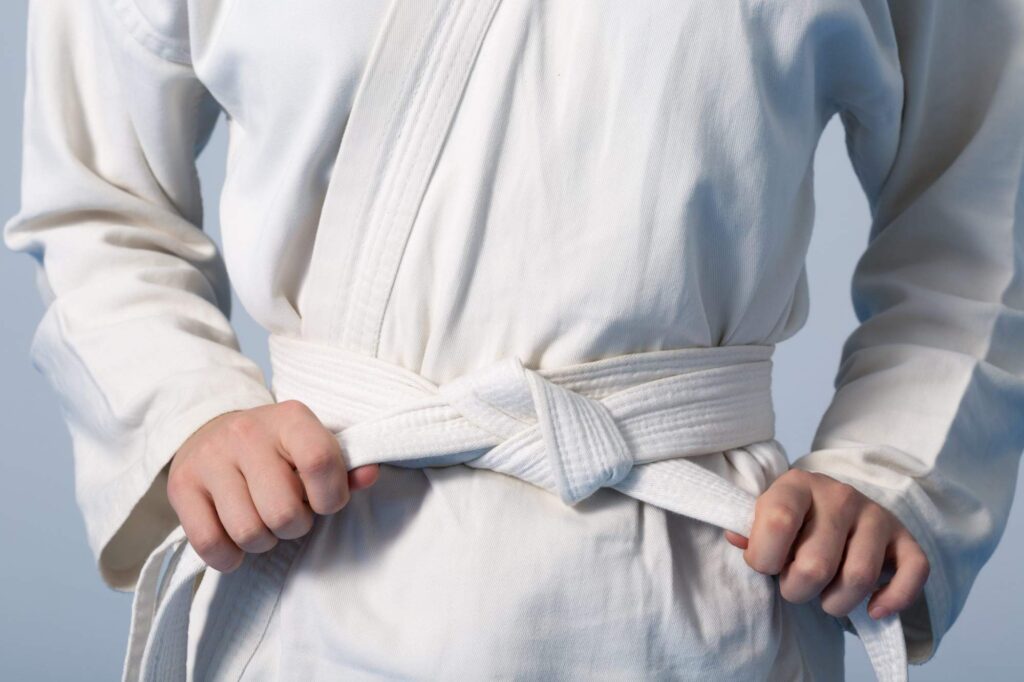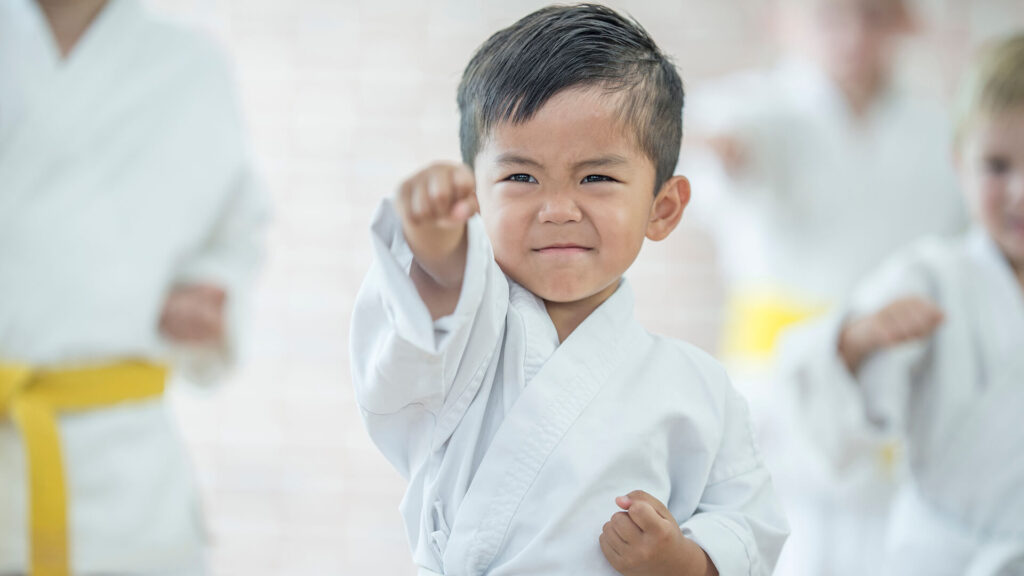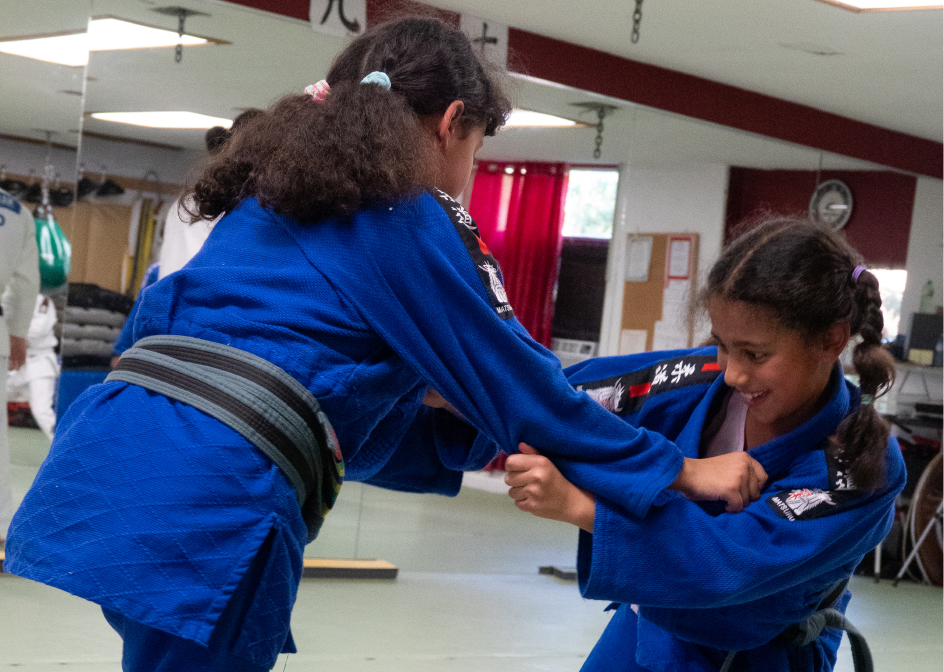Menu
Close
Menu
Close

Judo and Jiu-Jitsu are two popular martial arts that often get confused due to their similar Japanese origins and grappling techniques. While both focus on using an opponent’s strength against them, they differ significantly in their approach and emphasis. Judo focuses more on throwing techniques and upright grappling while Jiu-Jitsu emphasizes striking, ground fighting, throws and submission holds. Brazilian Jiu-Jitsu focuses almost exclusively on ground fighting.
When comparing these martial arts, we find that Judo practitioners typically aim to execute perfect throws that can instantly win matches, whereas Jiu-Jitsu fighters prioritize controlling opponents on the ground and securing submissions. This fundamental difference stems from their different developmental paths and competitive rule sets, despite sharing common historical roots.
Both martial arts offer valuable self-defence applications and promote personal growth through disciplined practice. However, choosing between them depends on your personal preferences – whether you’re drawn to the dynamic throwing techniques of judo or the technical ground-fighting strategy of Kosen Judo or Brazilian Jiu-Jitsu, it’s copy.
Both Judo and Jiu-Jitsu have rich histories rooted in Japanese martial traditions but followed different evolutionary paths. Their founding principles and development have shaped their unique approaches to combat and physical discipline.
Jigoro Kano founded Kodokan Judo in 1882 as a refined form of traditional Japanese jujutsu. Born in 1860, Kano studied various jujutsu styles before developing his own system that emphasized safety and efficiency.
His vision for Judo went beyond combat techniques. He created a discipline that balanced physical development with mental and moral education. The name “Judo” translates to “the gentle way,” or “way of yielding” reflecting Kano’s philosophy of maximum efficiency with minimum effort.
Kano established key principles like “mutual welfare and benefit” (Jita Kyoei) and “maximum efficiency, minimum effort” (Seiryoku Zenyo). These ideas became central to Judo’s identity as both a martial art and educational system.
Originally, Jiu-Jitsu, was a combat system used by Samurai in feudal Japan, focused on battlefield techniques.
In 1883 Jigoro Kano divided his students into graded students(yudansha) or ungraded students(mudansha). A number of years later, Shiro Saigo and Tsunehiro Tomita were later awarded as the first Black Belts in history being recognized in the history of judo(and all martial since Jigoro Kano created this system of ranks). Shiro Saigo participated in the 1886 Tokyo Metropolitan Police Judo vs Jujutsu tournament that was held to determine which martial art was superior in a true battle. It was sanctioned by the Chief of Tokyo Police, Mr.Mishima. Fifteen of Kano sensei’s best students, including Saigo were pitted against Totsuka-ha Yoshin-ryu jujutsu masters. The Totsuka team included jujutsu masters from other schools as well however most interest was focused on ten matches between Totsuka’s team vs the Kodokan.
“Totsuka Hikosuke” was thought as the strongest jujutsuka of the Bakumatsu Period or end of the shogunate. The Kodokan won all matches but one or two that ended in a draw. The final match was between a much larger and more experienced jujutsu master who later became head of Yoshin-ryu jujutsu vs Saigo. After a very difficult 15 minute fight Saigo executed a Yama Arashi forcing his opponent to retire with a concussion.
Judo gained international recognition, becoming an Olympic sport in 1964 for men and 1992 for women. This Olympic status standardized rules and competition formats worldwide.
The Olympic influence shaped Judo’s development, emphasizing dynamic throws and quick pins over prolonged ground fighting. Today, Judo competitions focus on achieving ippon (full point) through clean throws, submissions, or pins.
Judo has become integrated into physical education systems globally, while also attaining massive success in MMA with practitioners such as the great Fedor Emelianenko and Hidehiko Yoshida, UFC Champions Merab Dvalishvili, Ronda Rousey, Khabib Nurmagomedov, Fabricio Werdum, Vitor Belfort, Valentina Shevchenko, and Islam Makhachev.
Judo and Jiu-Jitsu employ distinctly different technical approaches and training methodologies that reflect their unique combat philosophies. These martial arts share historical roots but have evolved to emphasize different aspects of grappling.
In Judo, practitioners focus primarily on standing techniques and ground techniques. The art centers around powerful throws (nage-waza) that use an opponent’s momentum against them. Common throws include seoi-nage (shoulder throw), uchi-mata (inner thigh throw), and o-soto-gari (major outer reap).
Judo training emphasizes kuzushi (balance breaking) as the foundation for all throws. We practice these techniques through uchi-komi (repetitive entry drills) and randori (free practice).
While less emphasized than throws, Judo’s groundwork (ne-waza) includes:
Training follows a structured approach with formal kata practice alongside dynamic randori sessions. Most Judo classes dedicate about 70% of training time to standing techniques and 30% to groundwork.
Brazilian Jiu -Jitsu emphasizes ground control and submissions inverting Judo’s priority. BJJ practitioners like Kosen judo practitioners use sophisticated guard positions and transitions that enable a smaller fighter to control larger opponents. The downfall to too much ground work is that the stand up techniques and kumi kata(gripping skills) suffer thereby making it less popular for those wanting more stand up skill for self-defence.
The guard position forms the cornerstone of Kosen Judo and BJJ training, with various types including:
Kosen Judo and BJJ’s submission arsenal is extensive, featuring detailed applications of:
Training revolves around positional drilling and extensive “rolling” (BJJ’s term for sparring). We see less emphasis on formal kata and more focus on practical application through problem-solving scenarios.
Judo and BJJ employ noticeably different training methodologies. Judo training tends to be more regimented, with formal bowing, consistent warm-ups, and structured technique practice.
In Judo, randori usually begins standing and follows strict rules about gripping and time limits on ground engagement. Competitions heavily influence training, with Olympic rules shaping practice priorities.
BJJ training is typically more relaxed in format but intense in application. Rolling sessions often last 5-7 minutes with multiple partners and commonly start from the ground position.
Key differences in sparring include:
We also see differences in drilling approaches. Judo employs more partner-based uchi-komi (repetition training), while BJJ features more solo drills like shrimping and technical stand-ups alongside partner work.
Both Judo and Brazilian Jiu-Jitsu have evolved as effective martial arts for competition and real-world self-defence. They differ significantly in their competitive formats and practical applications outside the dojo.
In Judo tournaments, competitors aim to score through clean throws, pins, or submission techniques. The highest score, called ippon, can be achieved by throwing an opponent onto their back with force and control. This immediately ends the match with victory.
Lesser scores include waza-ari (partial throw) and penalties called shidos given to passive competitors. A judoka can win by accumulating points or when their opponent receives too many penalties.
Tournament matches are typically short about 4-5 minutes encouraging decisive action. Competitors wear traditional judogi and coloured belts signifying rank.
The standing position dominates Judo competition, with referees often restarting matches if ground fighting becomes stalled. This emphasis on quick, powerful throws makes Judo particularly effective for self-defence situations where staying on your feet is crucial.
Both judo and jiu-jitsu have shaped physical education systems and influenced other martial arts worldwide. Their philosophies extend beyond combat to personal development and discipline.
Judo has been integrated into many school systems globally as it teaches valuable life skills. In Japan, judo is part of the physical education curriculum, focusing on discipline, respect, and physical fitness.
The formal aspects of judo, including bowing and wearing the judogi, instill respect and proper etiquette in students. These traditions carry important cultural values that originated in Japan.
BJJ clubs often emphasize a more relaxed atmosphere compared to traditional judo clubs.
The discipline learned on the mat often translates to improved focus in academic performance.
Judo’s Olympic inclusion has significantly boosted its global popularity and standardized its practice across continents.
We’ve also seen influence flow to other arts like aikido, which shares some technical elements with judo. Modern MMA fighters often incorporate elements of both judo and combat sambo in their training regimens.
Traditional Japanese martial arts like sumo have historical connections to judo and jiu-jitsu techniques. This cross-pollination has enriched each discipline while preserving their unique identities.
Many martial artists have questions about the differences between Judo and Jiu-Jitsu. These grappling arts share common roots but have evolved distinct approaches to techniques, training methods, and competitive focus.
How do the ground fighting techniques in Judo compare to those in Jiu-Jitsu?
Judo ground fighting (newaza) focuses primarily on pins, holds, and a limited set of submissions. The goal is typically to immobilize an opponent or secure a quick submission.
In contrast, Jiu Jitsu, like Combat Sambo specializes in ground strategies with a much broader range of submission techniques.
Judo competitions allow limited time on the ground before standing fighters up, while BJJ matches can remain on the ground for their entire duration.
What are the training and competition rule differences between Judo and Brazilian Jiu-Jitsu (BJJ)?
Judo competitions award ippon (full point) for clean throws, 25-second pins, or submissions. Matches are typically shorter, with emphasis on decisive techniques and quick finishes.
BJJ competitions award points for positional control, sweeps, and takedowns, with matches often going the full time limit. Submissions end the match but aren’t required for victory.
Judo prohibits many leg attacks and certain grips, while BJJ like Sambo allow techniques including most leg locks and various gripping strategies. Unlike BJJ Sambo also allows hip locks.
Which martial art is more effective for self-defence situations, Judo or Jiu-Jitsu?
Judo provides excellent standing skills with powerful throws that can be devastating on hard surfaces. The ability to control an opponent’s balance and position works well in confrontations where staying on your feet is crucial.
BJJ offers more ground control, which helps when confrontations inevitably end up on the ground.
We believe both arts have complementary self-defence benefits.
Can Judo skills be effectively used against a practitioner of Jiu-Jitsu, and vice versa?
Judoka can use their superior throwing techniques to control where the fight goes, potentially scoring decisive throws against BJJ practitioners who may have less developed standing skills.
BJJ practitioners often have an advantage once the fight reaches the ground, with more practised submission techniques and defensive positions to counter Judo’s ground approach.
Cross-training is increasingly common, with many fighters borrowing techniques from both arts.
What are the historical origins of Judo compared to those of Jiu-Jitsu?
Traditional Japanese Jiu-Jitsu (or Jujutsu) emerged in feudal Japan as a battlefield martial art incorporating strikes, throws, joint locks, and weapons training.
Judo was developed in the late 1800s by Jigoro Kano, who refined traditional Jiu-Jitsu techniques into a sport and educational system. He eliminated dangerous techniques and emphasized safe practice.
Brazilian Jiu-Jitsu evolved when Mitsuyo Maeda taught Judo to the Gracie family in Brazil in the early 20th century. The Gracies adapted these techniques with a stronger focus on ground fighting.
In terms of fitness and physical conditioning, how do Judo and Jiu-Jitsu programs differ?
Judo training typically develops explosive strength, balance, and cardiovascular endurance. The repeated throwing practice and dynamic movements create a high-intensity workout focusing on burst energy systems.
BJJ training builds isometric strength, flexibility, and muscular endurance. The extended ground exchanges emphasize efficiency of movement and energy conservation over long periods.
Both arts develop excellent core strength and body awareness. However, Judo generally demands more standing work while BJJ emphasizes ground conditioning, resulting in slightly different physical adaptations over time.



Hours of Operation:
Monday – Friday
8:00 a.m. – 8:00 p.m.
Saturday – Open Mats
2:00 p.m. – 3:00 p.m.
Recent Posts
Blog
The Beginner’s Guide to Starting Martial Arts: Essential First Steps for New Practitioners
Judo vs. Jiu-Jitsu: Understanding the Key Differences Between These Ancient Martial Arts
Why Martial Arts are Excellent for Child Discipline: Building Character Through Structure and Respect
How Martial Arts Teach Children Anti-Bullying Skills: Building Confidence and Self-Defence
Copyright © 2024 |
Tina Takahashi Martial Arts
Designed by
ElissDesign.com





